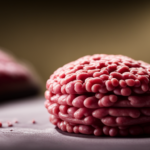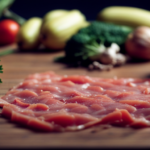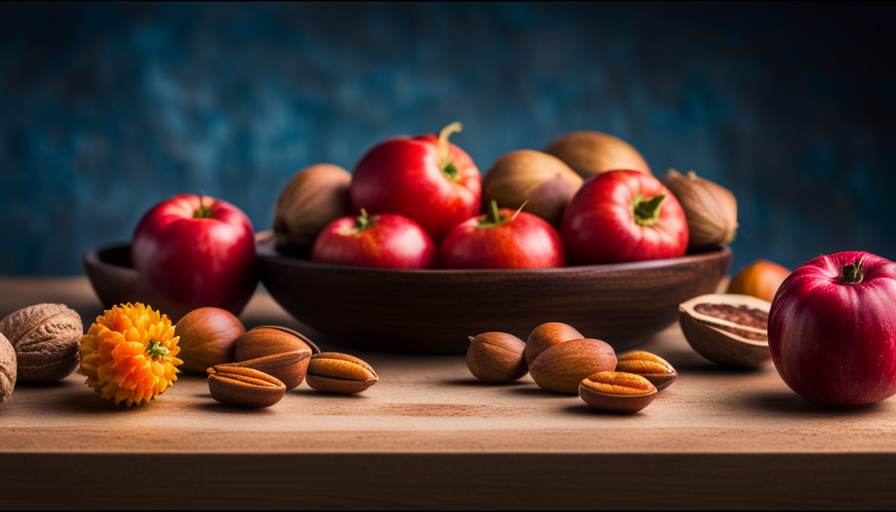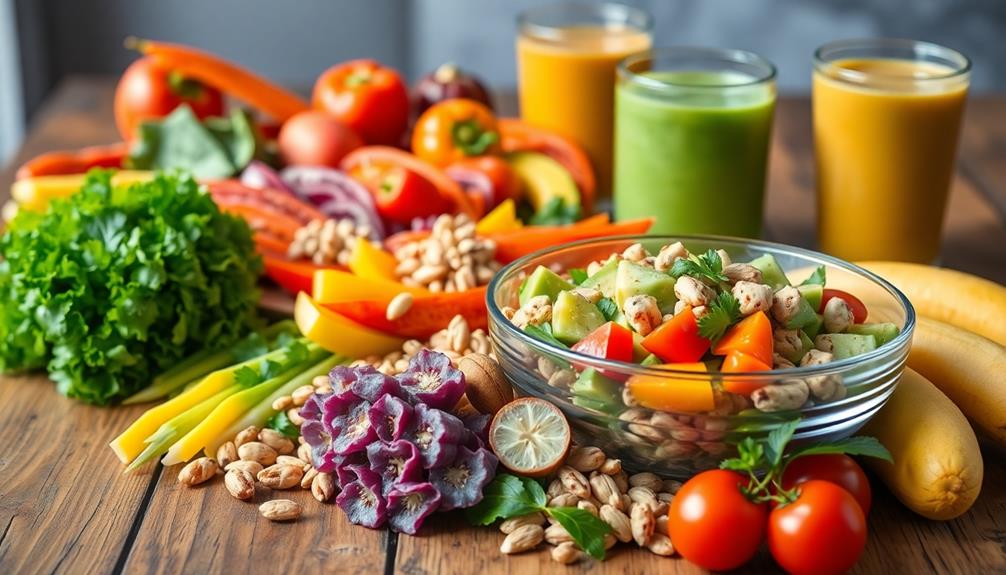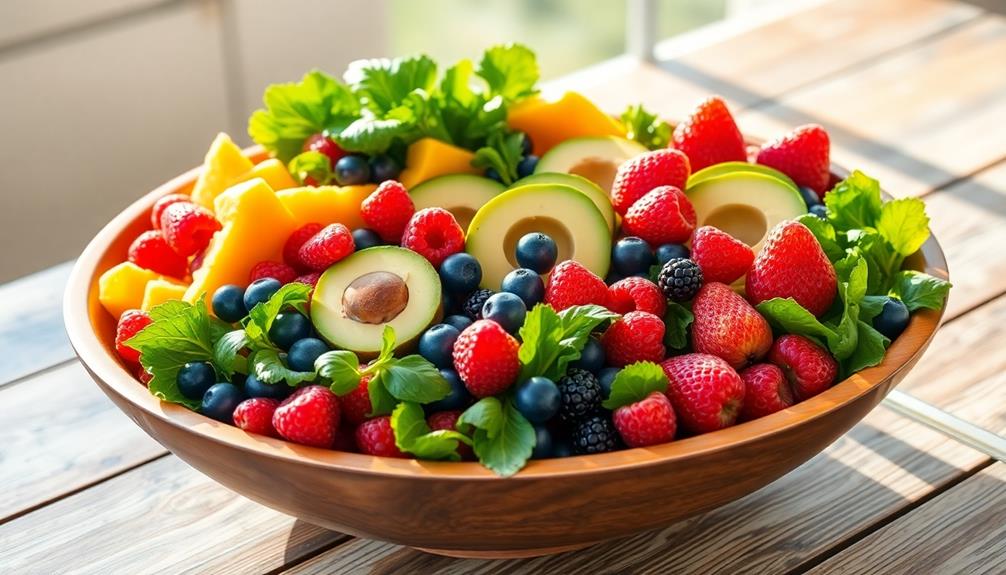Picture a well-organized kitchen, with colorful fruits and veggies neatly placed in a bowl, and freshly baked bread cooling on the counter. The scent of scrumptious meals being cooked fills the air. However, lurking behind this idyllic setting is a hidden threat – the danger of cross-contamination. Just one slip-up can transform this cooking heaven into a hub for harmful bacteria.
That’s why it’s crucial to understand the importance of proper food storage techniques. One of the most effective ways to prevent contamination is by storing raw food away from other food. By doing so, we can minimize the risk of harmful bacteria spreading and ensure the safety of our meals.
In this article, I will delve into the reasons why this simple yet powerful practice is essential for maintaining food safety. Let’s explore the world of cross-contamination and discover the preventive measures we can take to keep our kitchens safe and our meals delicious.
Key Takeaways
- Storing raw food away from other food prevents cross-contamination.
- Proper storage techniques include using sealed containers or plastic bags for raw meat, poultry, and seafood.
- Keeping raw foods on the bottom shelf of the refrigerator minimizes the risk of leaks onto other foods.
- Using separate cutting boards, utensils, and plates for raw and cooked foods helps prevent the spread of harmful bacteria.
The Importance of Food Safety Practices
You should always remember to store raw food away from other food in order to prevent any kind of contamination. This is one of the most important food safety regulations and best practices.
Keeping raw food separate from other food items is crucial to avoid the transfer of harmful bacteria and pathogens. Cross-contamination can occur when raw food comes into contact with ready-to-eat food or surfaces used for food preparation. By storing raw food separately, you minimize the risk of spreading bacteria and protect the safety of your meals.
Food safety regulations dictate that raw meat, poultry, and seafood should be stored in sealed containers or wrapped securely to prevent any juice or drippings from contaminating other food items. It is recommended to store raw food on the lowest shelves of the refrigerator to prevent any potential leaks from dripping onto other foods. Additionally, storing raw food separately reduces the chances of cross-contamination during transportation and handling.
Understanding cross-contamination is essential to maintaining food safety. Cross-contamination occurs when bacteria from one food item spreads to another, either directly or indirectly. By storing raw food away from other food, you minimize the risk of cross-contamination and ensure the safety of your meals.
Understanding Cross-Contamination
Understanding cross-contamination is crucial for maintaining food safety. Cross-contamination occurs when harmful bacteria or other microorganisms are transferred from one surface or food to another, leading to the potential spread of foodborne illnesses.
The main causes of cross-contamination are improper handling of raw food, inadequate cleaning and sanitizing of kitchen surfaces, and using the same utensils or cutting boards for different types of food.
The potential risks and consequences of cross-contamination can be serious, as it can result in foodborne illnesses that can lead to hospitalization or even death, especially for vulnerable populations such as young children, pregnant women, and the elderly.
Definition and Causes
To grasp the concept and causes of food contamination, imagine a pantry where raw food is kept at arm’s length from other food items, acting as a shield against the potential invasion of harmful bacteria. Here are three important aspects to consider:
-
Proper storage techniques: Storing raw meat, poultry, fresh produce, raw eggs, and kitchen tools and equipment separately helps prevent cross-contamination.
-
Labeling and organization: Properly labeling food storage containers and using the FIFO (first in, first out) method when organizing the refrigerator and pantry can minimize the risk of contamination.
-
Safe handling and leftovers: Educating others about safe handling practices and ensuring leftovers are stored promptly and at the correct temperature contribute to food safety.
Understanding these preventive measures is crucial in mitigating potential risks and consequences associated with foodborne illnesses.
Transitioning into the subsequent section, it’s important to explore the potential risks and consequences in more detail.
Potential Risks and Consequences
Be aware of the potential risks and consequences that can arise from food contamination. When raw food is not stored properly and away from other food, it can lead to potential health hazards.
Cross-contamination can occur, where harmful bacteria from raw food can transfer to other items, such as fruits and vegetables, leading to foodborne illnesses. These illnesses can range from mild stomach discomfort to more severe symptoms, such as vomiting and diarrhea.
To prevent such risks, it’s important to follow preventive strategies, such as storing raw food separately and using separate cutting boards and utensils for raw and cooked foods. By practicing proper storage techniques, you can minimize the chances of contamination and ensure the safety of your meals.
Proper Storage Techniques
Keep your raw food stored separately from other items like a fortress protecting your precious groceries, warding off the lurking dangers of cross-contamination. To ensure the safety of your food, it’s crucial to follow proper storage techniques.
First and foremost, maintaining the proper temperature is essential. Raw food should be stored at temperatures below 40°F (4°C) to prevent the growth of harmful bacteria.
Additionally, proper packaging is key. Store raw food in leak-proof containers or wrap them tightly in plastic wrap to avoid any potential leakage that could contaminate other items.
Furthermore, it’s important to take into account the specific needs of different types of raw food. For example, raw meat should be stored on the bottom shelf of the refrigerator to prevent any juices from dripping onto other items. Similarly, raw seafood should be stored in a separate container to avoid any potential cross-contamination with other food items.
By following these proper storage techniques, you can greatly reduce the risk of cross-contamination and ensure the safety of your food.
In the next section, we’ll discuss preventive measures in the kitchen to further enhance food safety.
Preventive Measures in the Kitchen
Get creative in the kitchen and implement some simple steps to make sure your meals are safe and delicious. One important aspect of food safety is proper cleaning and sanitizing procedures. By following these practices, you can prevent contamination and keep your kitchen a safe environment for preparing meals.
To start, always remember to wash your hands thoroughly before handling any food. This will help remove any bacteria or germs that may be present on your hands.
Additionally, regularly clean and sanitize your kitchen surfaces, utensils, and cutting boards. This will eliminate any potential sources of contamination.
When it comes to storing raw food, it is crucial to keep it separate from other food items. This prevents cross-contamination, where harmful bacteria from raw food can spread to other foods and cause illness. Store raw meat, poultry, and seafood in sealed containers or plastic bags to prevent any juices from leaking and contaminating other foods.
By implementing these preventive measures, you can ensure that your meals are safe and free from any harmful contaminants.
In the subsequent section, we will explore common sources of cross-contamination and how to avoid them. Remember, food safety starts with proper cleaning and sanitizing procedures.
Common Sources of Cross-Contamination
When it comes to preventing cross-contamination in the kitchen, there are a few common sources that need to be addressed.
First, raw meat and poultry can easily contaminate other foods if they’re not handled properly.
Second, fresh produce, such as fruits and vegetables, can also be a source of cross-contamination if they’re not washed thoroughly.
Lastly, kitchen tools and equipment, such as cutting boards and knives, can harbor bacteria if they’re not cleaned and sanitized properly.
It’s important to be vigilant in these areas to ensure food safety.
Raw Meat and Poultry
Storing raw meat and poultry separately from other food items is a crucial measure to avoid cross-contamination, ensuring that harmful bacteria doesn’t spread and contaminate other ingredients. Did you know that a single drop of raw chicken juice can contain millions of bacteria?
To ensure safe handling, it’s essential to follow these guidelines:
- Store raw meat and poultry in sealed containers or leak-proof bags to prevent any drips or spills.
- Keep raw meat and poultry on the bottom shelf of the refrigerator to prevent any potential leaks from contaminating other foods.
- Use separate cutting boards, utensils, and plates for raw meat and poultry to avoid cross-contamination during preparation.
Proper cooking is another important step in preventing foodborne illnesses. It’s crucial to cook raw meat and poultry to the recommended internal temperatures to kill any harmful bacteria.
Now let’s move on to the next section about fresh produce and raw eggs.
Fresh Produce and Raw Eggs
Fresh produce and raw eggs should always be handled and stored separately from meat and poultry to minimize the risk of cross-contamination.
When it comes to fresh produce handling, it’s important to wash fruits and vegetables thoroughly under running water to remove any dirt or bacteria. Additionally, cutting boards and utensils used for handling raw produce should be cleaned and sanitized before using them for other foods.
As for egg safety, it’s crucial to store eggs in the refrigerator at or below 40°F to prevent the growth of harmful bacteria like Salmonella. It’s also recommended to cook eggs thoroughly to kill any potential pathogens.
Proper handling and storage of fresh produce and raw eggs play a vital role in ensuring food safety.
Moving on to kitchen tools and equipment, it’s essential to keep them clean and in good condition to prevent contamination.
Kitchen Tools and Equipment
Make sure you keep your kitchen tools and equipment clean and in good condition to ensure a safe and hygienic cooking environment. Proper cleaning of kitchen tools is crucial for kitchen sanitation.
Regularly wash and sanitize cutting boards, knives, utensils, and other equipment to prevent cross-contamination between different foods. Use hot soapy water and a scrub brush to remove any visible dirt or residue from the tools. Then, sanitize them by soaking in a solution of one tablespoon of bleach mixed with one gallon of water. Rinse thoroughly and air dry before using again.
Remember to also check for any damaged or worn-out tools that may harbor bacteria or pose a safety hazard. By practicing proper cleaning and maintenance of kitchen tools, you can reduce the risk of foodborne illnesses.
Transitioning into the next section, understanding foodborne illnesses is essential for maintaining a safe kitchen environment.
Understanding Foodborne Illnesses
To keep yourself safe from foodborne illnesses, it’s important to store raw food separately from other food items. This helps prevent cross-contamination, which is when bacteria from raw foods spread to other foods and cause illness.
When different types of food are stored together, the juices from raw meat, poultry, or seafood can drip onto other foods, such as fruits and vegetables, leading to the transfer of harmful pathogens.
To ensure proper foodborne illness prevention, follow these guidelines:
- Store raw meat, poultry, and seafood in sealed containers or plastic bags to prevent their juices from leaking onto other foods.
- Keep raw foods on the bottom shelf of the refrigerator, away from cooked or ready-to-eat foods, to prevent any potential drips or spills from contaminating other items.
- Use separate cutting boards, utensils, and plates for raw and cooked foods to avoid cross-contamination during food preparation.
By following these practices, you can reduce the risk of foodborne illnesses caused by common pathogens like salmonella, E. coli, and listeria.
Next, let’s explore the importance of labeling and organization in maintaining food safety and preventing cross-contamination.
Importance of Labeling and Organization
Properly labeling food storage containers is crucial to maintaining food safety. By clearly indicating the contents and expiration dates on each container, it becomes easier to identify and use items in a timely manner. Additionally, following the FIFO (First-In, First-Out) method ensures that older products are used before newer ones, reducing the risk of food spoilage.
Lastly, organizing the refrigerator and pantry allows for easy access to items, minimizing the chances of cross-contamination and ensuring that perishable foods are stored at the correct temperatures.
Properly Labeling Food Storage Containers
Labeling food storage containers ensures that raw food is kept separate from other food, preventing any potential contamination. With each label acting as a culinary sentinel, the risk of cross-contamination is thwarted, allowing for a harmonious coexistence of flavors and ingredients.
To properly label food storage containers, there are a few key practices to follow:
-
Use clear and concise labels: Clearly state the contents and date of storage on each container to easily identify the food and ensure it’s used within a safe timeframe.
-
Store similar items together: Grouping similar foods together makes it easier to locate specific ingredients and reduces the chances of accidentally using the wrong item.
-
Regularly check and update labels: As foods are used or new ones are added, it’s important to update the labels accordingly to maintain accurate information.
By following these proper storage practices and labeling food storage containers, we can effectively prevent cross-contamination and ensure the safety of our food.
Now, let’s delve into the next section about the FIFO (first-in, first-out) method.
FIFO (First-In, First-Out) Method
Make sure you’re using the FIFO method to keep your ingredients fresh and minimize waste.
The FIFO method, which stands for First-In, First-Out, is a simple but effective way to ensure that the oldest items in your food storage are used first. This method involves organizing your ingredients so that the ones with the closest expiration dates are in the front, while the newer ones are stored in the back. By doing this, you can prevent food from spoiling and avoid unnecessary waste.
Implementing the FIFO method also helps to maintain the quality of your ingredients, as you’re constantly using the oldest ones before they expire.
Once you’ve mastered the FIFO method and food rotation, you can move on to organizing your refrigerator and pantry seamlessly.
Organizing Refrigerator and Pantry
Now that we’ve discussed the FIFO (First-In, First-Out) method, let’s turn our attention to organizing our refrigerator and pantry for safe food handling.
It’s important to keep raw food separate from other food items to prevent cross-contamination. Storing raw food away from other food is an example of proper sanitation. By doing so, we reduce the risk of harmful bacteria spreading and causing foodborne illnesses.
When organizing your refrigerator, make sure to keep raw meat, poultry, and seafood on the bottom shelf, away from ready-to-eat foods. Use separate containers or bags to store raw food in the pantry, keeping them away from other packaged items.
Maintaining this organization will ensure that your food stays safe and prevent any potential contamination.
Speaking of safe handling, let’s now move on to the next section about the proper handling of leftovers.
Safe Handling of Leftovers
Storing raw food separately from other food is like building a fortress to protect your leftovers from the sneaky bacteria invaders. Safe handling is crucial when it comes to preventing contamination and ensuring the safety of your leftovers.
Leftovers can easily become a breeding ground for harmful bacteria if not handled properly. To safely handle leftovers, it’s important to follow a few simple guidelines.
First, make sure to refrigerate leftovers promptly after they’ve cooled down. Bacteria thrive in warm temperatures, so keeping them chilled slows down their growth. Additionally, it’s important to store leftovers in airtight containers to prevent cross-contamination with other foods in the refrigerator. This will help maintain the integrity of your leftovers and prevent any potential contamination.
Furthermore, when reheating leftovers, always make sure they reach a safe internal temperature of 165°F (74°C) to kill any bacteria that may be present. This can be easily done using a food thermometer. Lastly, it’s essential to consume leftovers within a few days to minimize the risk of foodborne illness.
By following these safe handling practices, you can protect yourself and your loved ones from foodborne illnesses caused by contaminated leftovers. Educating others on food safety is important to ensure everyone understands the importance of safe handling and preventing contamination.
Transitioning into the next section, it’s crucial to spread awareness and share these essential food safety practices with others.
Educating Others on Food Safety
Take a moment to educate those around you about the importance of food safety to ensure their well-being and protect them from the potential dangers lurking in their leftovers. Food safety education is crucial in promoting hygiene practices and preventing foodborne illnesses. Here are three key points to convey to others:
-
Proper storage: Teach them the significance of storing raw food away from other food to prevent cross-contamination. This simple step can help avoid the spread of harmful bacteria and keep their meals safe to consume.
-
Temperature control: Emphasize the importance of keeping hot foods hot and cold foods cold. Explain that maintaining proper temperatures can inhibit the growth of bacteria, reducing the risk of foodborne illnesses.
-
Hand hygiene: Educate them about the necessity of washing hands thoroughly before handling food. Stress that proper handwashing can eliminate harmful bacteria and prevent its transfer onto food, ensuring safe consumption.
By sharing this knowledge, we can all contribute to a safer food environment for ourselves and our loved ones.
Transitioning into the next section about continuous improvement and adaptation, it’s important to remember that food safety practices are constantly evolving.
Continuous Improvement and Adaptation
Ensure the continuous improvement and adaptation of your food safety practices by staying informed about the latest advancements and guidelines in order to protect yourself and others from potential risks. Continuous improvement refers to the ongoing effort to enhance and refine your food safety practices based on new information and best practices. By staying up to date with the latest advancements, you can identify areas for improvement and implement changes to prevent foodborne illnesses.
Adaptation is crucial in the ever-evolving field of food safety. As new risks emerge and technologies advance, it is important to adapt your practices accordingly. This involves being open to change, embracing new methods, and adjusting your approach as needed. By remaining adaptable, you can address emerging risks and ensure that your food safety practices remain effective.
To visually represent the ideas of continuous improvement and adaptation, I have created a table:
| Continuous Improvement | Adaptation |
|---|---|
| Stay informed about the latest advancements and guidelines | Be open to change and embrace new methods |
| Identify areas for improvement and implement changes | Adjust your approach to address emerging risks |
| Refine your food safety practices based on new information | Ensure that your practices remain effective |
By incorporating continuous improvement and adaptation into your food safety practices, you can enhance your ability to prevent contamination and protect the health and well-being of yourself and others. Stay informed, be open to change, and continually refine your practices to stay ahead of potential risks.
Frequently Asked Questions
What are the potential consequences of not storing raw food away from other food?
Not storing raw food away from other food can lead to potential health risks and increase the likelihood of foodborne illnesses. Cross-contamination may occur, where bacteria from raw food can transfer to other foods, causing contamination and potential illness when consumed. This can result in symptoms such as nausea, vomiting, diarrhea, and even more serious complications.
It’s essential to store raw food separately to minimize the risk of contamination and ensure food safety.
Can cross-contamination occur even if raw food is stored separately from other food?
Yes, cross-contamination can still occur even if raw food is stored separately from other food. This happens when there’s improper handling or transfer of the raw food. For example, if I use the same cutting board or knife for both raw meat and ready-to-eat food without properly cleaning them in between, bacteria from the raw food can contaminate the other food.
It’s important to practice good food safety measures to prevent cross-contamination.
Are there any specific types of raw food that are more prone to causing cross-contamination?
Certain types of raw meat are more prone to causing cross-contamination, posing risks to food safety. Raw poultry, such as chicken and turkey, is known to be a major source of bacterial contamination, including pathogens like Salmonella and Campylobacter.
Ground meats, such as beef or pork, also carry a higher risk due to the increased surface area exposed to potential contaminants. It is crucial to handle and store these raw meats properly to prevent the spread of harmful bacteria and ensure food safety.
How can proper storage techniques help prevent cross-contamination?
Proper storage techniques are crucial in preventing cross-contamination. One important aspect is proper labeling, which helps identify and separate different types of raw food. This prevents the spread of harmful bacteria from one food item to another.
Additionally, best practices for storing raw food in a refrigerator include keeping them in sealed containers or bags, placing them on lower shelves to prevent drips onto other foods, and maintaining appropriate temperature conditions.
Following these guidelines ensures the safety and quality of our food.
Is there a specific distance or separation required between raw food and other food to prevent cross-contamination?
To prevent cross-contamination, it’s important to maintain a specific distance and separation between raw food and other food. While there aren’t any set rules regarding the exact measurements, it’s recommended to store raw food in separate containers or on different shelves. This helps minimize the risk of contamination by ensuring that harmful bacteria or pathogens from raw food don’t come into contact with ready-to-eat items. By doing so, the likelihood of foodborne illnesses is reduced.
How Does Storing Raw Food Away From Other Food Prevent Cross-Contamination?
Storing raw food correctly is crucial for preventing raw food crosscontamination. Keeping raw meat, poultry, and seafood separate from other foods can prevent harmful bacteria from spreading. This ensures that ready-to-eat foods are not contaminated with raw juices, reducing the risk of foodborne illnesses.
Conclusion
In conclusion, practicing proper food safety measures is crucial to prevent cross-contamination and ensure the health and well-being of ourselves and others.
One interesting statistic to note is that according to the Centers for Disease Control and Prevention (CDC), approximately 48 million people in the United States get sick from foodborne illnesses each year. This highlights the importance of following preventive measures, such as storing raw food away from other food, to reduce the risk of contamination and protect our health.
Remember, a little caution goes a long way in maintaining food safety.




